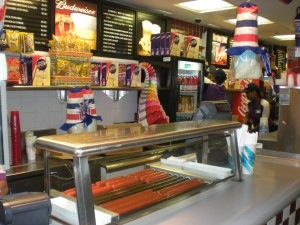



Where Would You Rather Eat?
Duh!!! Obviously, most people would choose the beautiful settings in the Martha’s Vineyard or Tuscany pictures — or anywhere in the world that is just as serene and welcoming.
But . . . the real question is: what is your goal?
The Setting And Your Surroundings Will Affect How Much You Eat
They will also affect how fast you eat and how long you take to eat. According to Brian Wansink, author of Mindless Eating and director of Cornell’s Food and brand Lab, the atmosphere of a restaurant can get you to overeat in two ways: if it’s really pleasant you want to stay longer — and therefore order and eat more, or if it is very brightly lit and perhaps loud and irritating you usually gulp and run, probably overeating before you realize that you’re full.
Red and Gold Decor Versus White Tablecloths
Fast food and high turnover restaurants are decorated for speed eating. No pleasant pastels and soft music here. Instead you’ll find loud music, noise reflecting off of hard surfaces, and high arousal color schemes, often red and gold. It takes about 20 minutes for your stomach to communicate to your brain that you are full and this red and gold, noisy environment makes you gulp your food and reach for more way before 20 minutes have come and gone.
On the other hand, people tend to linger at restaurants with low lighting, soft music, flowers, and tablecloths. The attentive waitstaff are there to offer you more and more food courses — and you are likely to jump at the offer(s). In this type of eating environment you end up ordering and eating more than you had planned.
SocialDieter Tip:
Restaurant decor is not an accident — it is designed with the intention of keep you at the table longer or getting you to eat and run. How long does it take you to gobble down a Big Mac or chow mein? The red and gold color schemes in many Chinese and fast food restaurants encourage you to chow down quickly. The white tablecloths and soft music of the “fancy” restaurant you frequent make it oh so easy to linger longer — and order another glass of wine, dessert, coffee, and after dinner drink. Know your setting: pace yourself in the speed environment and avoid the temptation to keep ordering in the relaxed environment.



